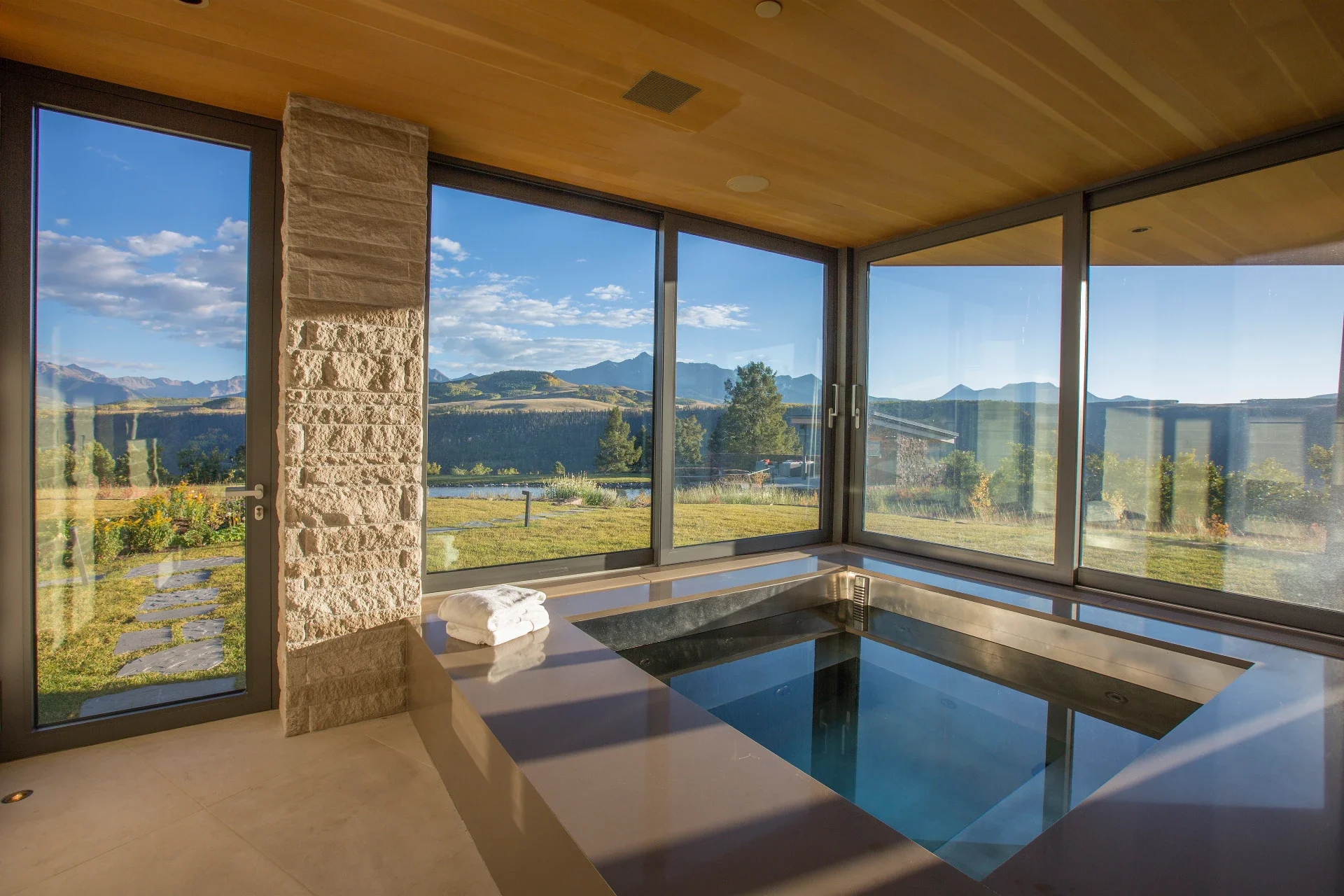Knowing who to hire can be confusing when starting a home project. Many people use “interior architecture” and “interior design” as if they mean the same thing. In reality, they refer to different roles that contribute in different ways. One shapes how a space is built, while the other shapes how it works and feels.
This article explains the difference between interior architecture and interior design, when each is needed, and how they overlap. It also outlines skills, qualifications, project examples, and how we at POSS combine both services in one cohesive approach.
QuiWhat’s the Core Difference Between Interior Architecture and Interior Design?
Interior architecture focuses on a space's internal structure, including layout changes, walls, and integration of systems like plumbing or electrical. Interior design focuses on how a space functions and looks, covering finishes, lighting, furniture, and decor.
If you are considering moving walls, changing the ceiling height, or altering the structure, it would be beneficial to your project to hire an interior architect.When improving a room’s comfort, flow, or look without altering the structure, consider an interior designer.
Why This Distinction Matters When Designing a Home
Different professionals are trained to solve different problems. Starting a remodel without understanding who does what can lead to delays or extra costs. A designer can help choose lighting and layout, but may not be qualified to move plumbing or change a load-bearing wall. An interior architect can handle the structure but may not specialize in selecting materials or furnishings. Knowing the difference helps you build the right team from the start.
What Is Interior Architecture?
Interior architecture blends architectural planning with interior layout design. It applies architectural principles to the inside of buildings, focusing on how people use the space and how internal elements work together.
The Role of an Interior Architect
Interior architects redesign space layouts, relocate structural walls, and integrate systems like HVAC or lighting. Our interior architects often partner with engineers and contractors to ensure internal design works with building codes and long-term use. They ensure spaces function efficiently while supporting architectural goals, especially during remodels or new builds.
They also address constraints that may not be visible at first glance. For instance, if a client wants a larger kitchen island, an interior architect checks if support beams, electrical routing, or fire-safety rules affect that change.
Education, Credentials, and Licensing
Interior architects often hold degrees in architecture or interior architecture. Many are licensed or work under licensed architects. Their education includes building systems, life safety, and construction technology. Licensing varies by state, but the title “interior architect” can only be used by those with proper credentials where it's required.
They often complete internships under practicing architects before qualifying for exams like the Architect Registration Examination (ARE). This rigorous process ensures they’re trained to make safe, functional decisions.
When to Hire an Interior Architect
When changing a building’s internal structure, you should hire an interior architect. This includes opening floor plans, installing new staircases, or updating plumbing routes. Their expertise is essential when the work affects a home’s skeleton or systems, not just its surface appearance.
For example, if your home needs more natural light and you’re considering larger windows or removing interior walls, an interior architect can determine which structural changes are possible and how to execute them safely.
What Is Interior Design?
Interior design focuses on a space's experience. It guides choices that affect comfort, use, and atmosphere. Designers work with color, proportion, lighting, and materials to support how people live in a space.
The Role of an Interior Designer
Interior designers plan room layouts, select furnishings, and develop visual direction. They may design custom cabinetry, coordinate lighting layers, or create palettes that reflect client personalities. A POSS team of designers shapes interiors to balance personality with utility.
Our team considers how natural light interacts with materials, how textures contribute to comfort, and how each room transitions into the next. POSS’s work shapes how a home feels and how it looks.
Key Skills and Scope of Work
Good designers understand visual hierarchy, spatial rhythm, and finish durability. They manage vendor sourcing, oversee installations, and handle revisions to align everything with a client’s goals. They also provide continuity by ensuring all elements across a home work together cohesively.
They’re also adept at budgeting. A skilled designer can often create a high-impact space while working within specific cost and lead-time constraints, making practical decisions that still support the client’s aesthetic.
When to Hire an Interior Designer
Hire an interior designer when your space needs improved comfort, function, or appearance but doesn’t require structural change. Whether it's furnishing a new home or refreshing dated finishes, a designer can elevate a space while saving you time and guesswork.
Interior Designers are also helpful in pre-construction planning. Choosing finishes, fixtures, and color schemes early avoids delays and costly revisions during build-out.
Shared Skills Between Interior Architects and Interior Designers
While their roles are distinct, interior architects and designers often bring overlapping skills to projects, especially in residential work.
Creativity, Spatial Awareness, and Design Thinking
Both disciplines require creative problem-solving. Interior architects explore structure, while designers focus on mood and interaction. But both rely on the ability to see beyond existing conditions to reimagine space.
For example, an interior architect might ensure new ceiling heights meet code in a basement remodel. A designer might work with them to ensure lighting and finishes make the space feel open and inviting despite the structural limits.
Client Collaboration and Project Communication
Clear communication is central to both professions. Listening to clients, interpreting feedback, and aligning technical details with lifestyle goals are all critical. At POSS, our teams meet regularly to coordinate decisions and maintain project clarity from start to finish.
POSS also manages third party collaborators such as contractors, fabricators, and suppliers to ensure everyone follows the same vision and scope.
Tools and Technologies Used Across Both Roles
Interior architects and designers visualize spaces using similar software, such as AutoCAD, Revit, and 3D rendering tools. They also use scheduling and budgeting platforms to keep projects moving efficiently. Integrated workflows allow both teams to problem-solve early and avoid delays later.
Virtual reality mockups, for example, allow clients to preview how a space will look and feel, even before a single nail is driven.
Interior Architecture vs Interior Design: Side-by-Side Comparison
Some confusion between these roles results from overlap. A direct comparison shows where they diverge and why both are often needed.
Structural vs Aesthetic Focus
Interior architects deal with structure, including what can be moved, added, or removed. Designers focus on atmosphere and how people feel in a space. One is grounded in code and construction; the other in use and style. Both bring lasting value.
Although they may both influence furniture placement, only the architect evaluates whether the ceiling can hold a pendant fixture or if wall bracing is required.
Collaboration vs Separation in Practice
Smaller projects might involve one professional doing both. Larger or more complex builds benefit from a team. At POSS, architects and designers work side by side, ensuring that layout choices complement material selections, lighting strategies, and design goals from the start. The clear advantage of hiring a studio or firm that provides architecture, interior architecture, and interior design under one roof, like POSS, is the seamless collaboration it brings to every project. With all three disciplines aligned from the start, projects benefit from a more efficient schedule, clear and consistent communication, and a unified vision shared across all teams. This integrated approach ensures that every detail works in harmony toward one goal: creating and delivering a successful, cohesive project.This results in fewer revisions and a more consistent experience for the client, mainly on fast-moving or high-end projects.
Comparison Table: Roles, Education, Scope, Cost
The table below summarizes the main distinctions between interior architects and interior designers, showing how their focus, education, and responsibilities differ while often complementing each other in practice.
| Attribute | Interior Architect | Interior Designer |
|---|---|---|
| Core Focus | Structure, layout, safety codes | Functionality, comfort, visual design |
| Education | Architecture or interior architecture degree | Interior design or related degree |
| Credentialing | Often licensed architect or supervised | Optional certifications like NCIDQ |
| Typical Projects | Remodels, new builds, system integrations | Furnishings, finishes, decor |
| Budget Range | Higher due to technical work | Moderate, depending on project scope |
| Tools Used | CAD, Revit, technical drawings | SketchUp, sourcing tools, mood boards |
Which Is Right for Your Project?
If your space needs structural changes, hire an interior architect. If it needs style, organization, or personalization, hire a designer. If it needs both, find a team that can integrate both roles effectively.
Decision Checklist: How to Choose Based on Project Needs
Replacing walls or windows? → Interior architect
Updating furnishings or layout? → Interior designer
Not sure or doing both? → A combined design team like POSS can help
How We Integrate Both at POSS
Our projects don’t pass from architect to designer in handoff stages. From start to finish, both work together under one roof.
A Unified Design Process, From Structure to Finish
We integrate architectural services and design planning from the outset, avoiding disjointed decision-making. The result is spaces that not only look beautiful but function with precision. Our process avoids conflicting decisions and keeps the project moving forward with clarity.
We’ve found that integrating teams leads to better decision-making, fewer surprises, smoother builds, and, ultimately, spaces that feel fully realized both visually and structurally.
Real-World Examples From Our Projects
At Elk Mountain Estate, we removed internal partitions to open the living area, then layered in warm materials, tailored furnishings, and lighting to create flow. In each case, architecture and design evolved together. This method reduces errors and supports a clearer client experience.
In another project, our team created a modern mountain retreat. The architecture emphasized natural light through clerestory windows, while the interiors softened the space with layered textures and custom millwork. The result was a seamless experience from frame to finish.
FAQs About Interior Architecture and Interior Design
Which Is Better for My Project: Interior Architecture or Interior Design?
Neither is better; they serve different purposes. Interior architecture encompasses structure and safety, whereas interior design focuses on comfort and overall experience. Select options based on your project's scope and objectives.
Do I Need an Interior Architect or an Interior Designer for My Home?
Choose an interior architect when safety, code compliance, and building systems are required. Select an interior designer to enhance the layout flow, comfort, lighting, and style without requiring structural modifications.
What Qualifications and Licenses Do Interior Architects and Interior Designers Typically Have?
Interior architects often hold degrees in architecture or interior architecture and may be licensed. Interior designers typically hold degrees and certifications in interior design, such as NCIDQ.
Is “Interior Architect” a Protected Title, and Can Interior Designers Use It?
In many places, the title "interior architect" is a protected designation reserved for licensed professionals. Interior designers should adhere to local regulations and use accurate titles to prevent misrepresentation.
How Do Costs Typically Compare Between Interior Architecture and Interior Design?
Interior architecture typically incurs higher costs due to its structural scope, engineering coordination, and permitting requirements. Interior design is often more flexible, with costs driven by materials, furnishings, and the level of complexity.





